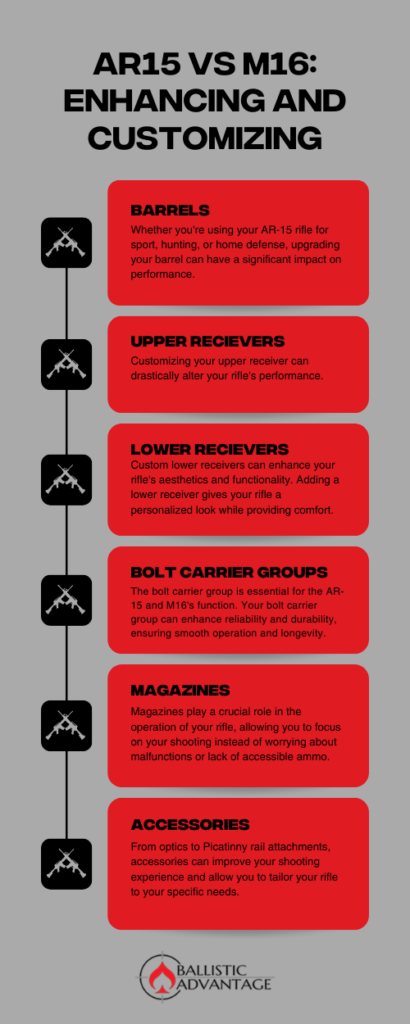When it comes to firearms, few are as iconic as the AR-15 and the M16 rifles. Originally designed by Eugene Stoner in the late 1950s, the Armalite rifle quickly caught the attention of the U.S. military, which adopted the M16 for service in the Vietnam War. Over time, the M16 evolved into the semi-automatic AR-15, which earned the title of "America's Rifle" and became one of the most popular civilian firearms in the United States. These rifles are a staple among gun enthusiasts, with a wide variety of aftermarket parts available to customize and enhance their performance.
Join us as we explore the rich history and unique characteristics of the AR-15 and M16 rifles, and discover the key features that make each of these rifles stand out.

AR-15 vs M16: Historical Breakdown
The history of the AR-15 and M16 rifles traces back to the late 1950s, when a talented engineer named Eugene Stoner, along with a team of engineers at the Armalite Corporation, developed a new weapon design. This design, initially referred to as the Armalite Rifle-15 (AR-15), was a scaled-down version of the earlier AR-10. The AR-15 was revolutionary, featuring a lightweight design, high-velocity ammunition, and innovative features that made it stand out from other firearms of its time.
The Rise of the M16 Rifle
The U.S. armed forces took notice of the AR-15's potential and, after some modifications, adopted the military version, naming it M16 during the Vietnam War. The M16 proved to be an effective weapon in the dense jungles of Vietnam, offering soldiers increased firepower, accuracy, and maneuverability. Over time, the M16 underwent several iterations, with changes to its barrel, receiver, and other components to improve its performance and reliability.
Colt Takes Over The Market
In the early 1960s, facing financial difficulties, Armalite sold the design and manufacturing rights for the AR-15 to Colt. The Colt company then introduced the AR-15 to the civilian market, marking the birth of what would become known as "America's Rifle." In the years that followed, the AR-15 became increasingly popular among gun enthusiasts, recreational shooters, and sportsmen in the United States.
Colt's manufacturing of the M16 for the U.S. military and the AR-15 for civilians continued, with the latter quickly gaining a reputation as a versatile, reliable, and customizable rifle. Over the years, many other manufacturers have joined the market, producing their versions of the AR-15 and expanding its availability to the public.
In the midst of the Vietnam War, Springfield Armory, the primary U.S. military small arms manufacturer at the time, had difficulty keeping up with the demand for M16 rifles. Colt stepped in to increase production and ensure that troops were well-equipped with this powerful and reliable weapon.
Fastforward to the Present Day AR-15 and M16
As the years passed, the AR-15 and M16 became embedded in American firearm culture. With countless aftermarket parts and accessories available, rifles have remained a favorite choice among gun owners and enthusiasts for their modularity, versatility, and adaptability.

AR-15 vs M16: Key Differences
The AR-15 and M16 rifles have become synonymous with precision and performance, but there are key differences between these two firearms that distinguish them from each other. The most significant distinction lies in their barrels, upper and lower receivers, and their functionalities. Understanding these differences will help you make an informed choice when selecting a rifle for your needs.
Barrels
- Barrel Length: The AR-15 typically has a shorter barrel, around 16 inches, compared to the M16's 20-inch barrel. This difference affects the rifle's accuracy and effective range. The M16's longer barrel provides higher velocity and better accuracy over longer distances, making it more suitable for military operations. The AR-15's shorter barrel makes it more maneuverable and easier to handle in close quarters, ideal for home defense or recreational shooting.
- Heavier Barrel: The M16 is often equipped with a heavier barrel than the AR-15, which reduces heat-related accuracy issues during prolonged firing. However, the AR-15's lighter barrel makes it more comfortable for civilian use, where sustained automatic fire is not common.
Upper and Lower Receivers
- Bolt Carrier: The bolt carrier in the AR-15 is designed for semi-automatic fire only, whereas the M16's bolt carrier is capable of both semi-automatic and automatic fire.
- Auto Sear: The M16 features an auto sear, a small device that allows the rifle to fire automatically when the trigger is held down. The AR-15 lacks this component, limiting it to semi-automatic fire.
- Charging Handle and Ejection Port: Both rifles have a charging handle and ejection port in their upper receivers. While the functions are similar, the M16's components are designed for the rigors of military use, while the AR-15's are optimized for civilian applications.
- Picatinny Rail: Both rifles can be equipped with a Picatinny rail on the upper receiver, allowing users to attach various accessories such as optics, lasers, and flashlights.
Functional Differences
- Semi-Automatic vs. Automatic: The most significant difference is that the AR-15 is a semi-automatic rifle, firing one shot per trigger pull, while the M16 can fire automatically, emptying its 20-round magazine as long as the trigger is held down.
- Safety Selector: The AR-15's safety selector typically has two positions: safe and fire. The M16's safety selector has three positions: safe, semi-automatic, and automatic or burst fire.
- Civilian vs. Military Use: The AR-15 is designed for civilian use and is subject to regulations that limit its features, while the M16 is a military rifle designed for combat situations.
Both the AR-15 and M16 have their unique advantages and are suited for different applications. Understanding their key features and differences can help you select the right rifle for your needs.
AR-15 and M16: Enhancing and Customizing Your Rifle

Choosing between the AR-15 and M16 will depend on your specific needs, but enhancing and customizing your rifle is a staple of both of these rifles and will significantly improve its performance while making it uniquely yours. We have put together a list of some of the most commonly customized AR-15 and M16 gun parts:
- Barrels: Whether you're using your AR-15 rifle for sport, hunting, or home defense, upgrading your barrel can have a significant impact on performance. For those looking to replicate the performance of an M16, a longer and heavier barrel is a great choice.
- Upper Receivers: Customizing your upper receiver can drastically alter your rifle's performance. An upgraded charging handle can make a world of difference in ease of use and reliability.
- Lower Receivers: Custom lower receivers can enhance your rifle's aesthetics and functionality. Adding a lower receiver with advanced ergonomics and aesthetics gives your rifle a unique and personalized look while providing a more comfortable shooting experience.
- Bolt Carrier Groups: The bolt carrier group is essential for the AR-15 and M16's function. Upgrading your bolt carrier group can provide enhanced reliability and durability, ensuring smooth operation and longevity.
- Magazines: Magazines play a crucial role in the operation of your rifle, allowing you to focus on your shooting instead of worrying about malfunctions or lack of accessible ammo.
- Accessories: From optics to Picatinny rail attachments, accessories can improve your shooting experience and allow you to tailor your rifle to your specific needs.
Customizing your AR-15 or M16 allows you to fine-tune its performance, look, and feel, making it a perfect match for your specific needs. Whether you're a newcomer or a seasoned gun enthusiast, Ballistic Advantage has the products and expertise to help you make the right choices for your rifle.
AR-15 vs M16: Deciding Which is Best For You
The AR-15 and M16 are both iconic rifles that have earned their place in American firearm history. While they share some similarities, they also have distinct features and applications that set them apart. The AR-15, designed for civilian use, offers versatility and customization options, making it a favorite among gun enthusiasts. The M16, a military rifle, has been a reliable and powerful weapon for U.S. armed forces since its adoption during the Vietnam War.
The wide array of customization options makes the AR-15 and M16 unique, and can significantly enhance its performance. Upgrading parts like the barrel, receivers, and bolt carrier group will improve your rifle's accuracy, reliability, and overall shooting experience.

How Our Mission Aligns With Your Love for The AR-15 and M16
At Ballistic Advantage, we understand that selecting the right components for your rifle can be challenging. Our experts are here to help you choose the best products for your specific needs, ensuring you get the most out of your rifle. Our wide selection of premium gun parts and accessories makes it easy for you to find the perfect components for your AR-15.Whether you're a recreational shooter, hunter, or gun enthusiast, Ballistic Advantage has the products and expertise to help you customize your rifle to its full potential. Explore our extensive range of barrels, upper receivers, lower receivers, muzzles, magazines, and more. Experience the difference that high-quality components can make in your shooting experience.
